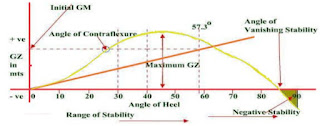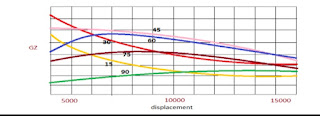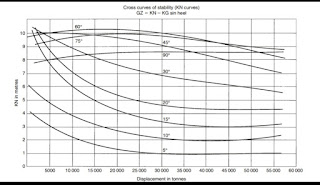Curve Of Statical Stability
> It is the most common graphical representation of ships transverse statical stability. Here the graph represents righting lever (GZ) against the angle of heel.
> This curve is plotted for every voyage and its for a particular KG and displacement
From this curve it is possible to get following:
> GZ value of any angle of heel
This can be used to find moment of statical stability at any given angle of heel
Righting Moment (t-m) = GZ x Displacement of the ship
> Initial metacentric height (GM) – Can be found by drawing a tangent to the curve through the origin and then erecting a perpendicular through the angle of heel of 57.3 degree. The 2 lines are allowed to intersect and the value of gz is noted which is the initial GM.
> Angle of contraflexure – The angle of heel up to which the rate of increase of GZ with heel is increasing. Though the GZ may increase further, the rate of increase of GZ begins to decrease at this angle.
> The range of stability – where all GZ values are positive. The maximum GZ lever & the angle at which it occurs.
>The angle of vanishing stability – beyond which the vessel will capsize.
> The area of negative stability.
>The moment of dynamical stability – work done in heeling the ship to a particular angle.
Cross curves
There are two more curves ie cross curves these are given by the shipyard under the stability booklet
GZ Cross Curves of Stability
> To draw the curve of statical stability (discussed above), we need GZ values for various angles of heel. For this we use the GZ cross curves of stability.
> The graph where the righting lever (GZ) is plotted against the displacement.
> These curves are plotted for an assumed KG, tabulating GZ values for various displacements and angles of list.
> It's called a cross curve because the various curves cross each other.
> The curves are plotted for an assumed KG, so actual KG differs from this and a correction (GG1sinθ) Should be applied
> This correction is positive if the actual KG is less than the assumed KG and vice-versa.
> After obtaining the GZ values at various angles, the curve of statical stability is prepared.
KN Cross Curves of Stability
Same as the GZ cross curves and also used to get the GZ values for making the curve of statical stability.
> The only difference being that here the KG is assumed to be ZERO. KN being the righting lever measured from the keel.
> This solves the problem of a sometimes positive and sometimes negative correction, as now the correction is always subtracted.
GZ = KN – KG Sine θ


